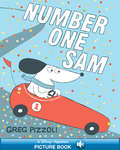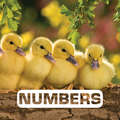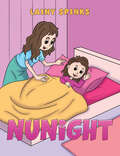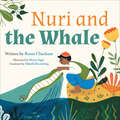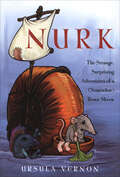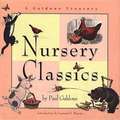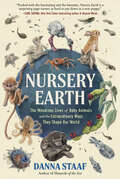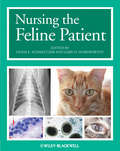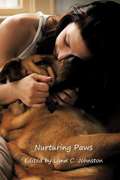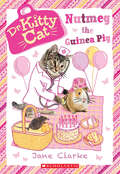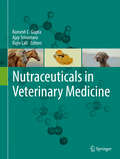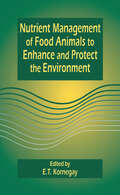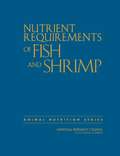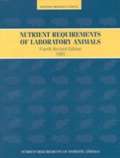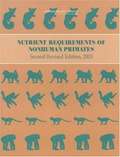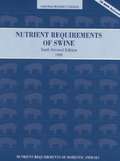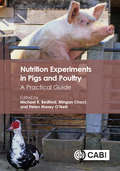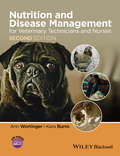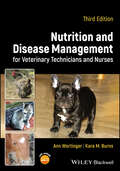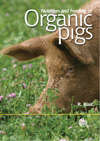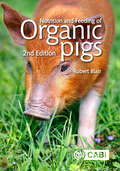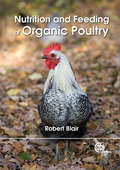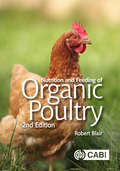- Table View
- List View
Number One Sam: A Read-Along Book
by Greg PizzoliAn acclaimed, winning tale about losing -- from champion humorist and three-time Geisel-recipient Greg PizzoliThey're off! Sam is the best race-car driver in history -- he is number one at every race! But when his best friend, Maggie, shows that she has racing talent of her own, Sam doesn't know how to handle coming in second place. Will he learn what it truly means to be a winner? With his signature light touch, Greg Pizzoli's upbeat story about being a good sport is perfect for read-aloud.* "Another winner from Pizzoli." ---Publisher's Weekly, starred review* "The simple yet exciting text drives the story forward and will make it a popular choice at storytimes." ---School Library Journal, starred reviewDon't miss these other favorites from Greg Pizzoli:The Watermelon SeedGood Night OwlThe Book HogThe Twelve Days of ChristmasTempleton Gets His WishThis Story is for You
Numbers (Picture This)
by Judith NouvionNumbers are everywhere in nature. From one tiny red-eyed frog to ten sweet and scruffy dogs, children will practice counting to ten all while finding out some fun facts about animals in our natural world. Vibrant photography and simple, fun read-aloud text make this board book a perfect first look at nonfiction for very new and curious learners! The Picture This series pairs learning concepts with extraordinary photographs of animals in their habitats. Check out all four books in the Picture This series: Colors, Homes, Numbers, and Shapes!
Nunight
by Lainy SpinksWhy do parents always put their kids to bed so early? What secret activities do they get up to before their own bedtime? Join a curious child as they try to uncover what parents really do after lights out. Is it a snack-filled party, a movie marathon, or something else? Find out in this fun, imaginative story about bedtime mysteries!
Nuri and the Whale
by Ronit Chacham“They say he met the King of the Sea, who taught him something important.” “And it all happened because he fed a fish!” “And it all happened because he shared what little he had.” Every day young Nuri makes his way to the sea shore to eat some bread and throw a piece into the waves. He does so because his father told him to “cast your bread on the water”. Even though Nuri can’t remember the second part of that beloved saying, but he follows his father’s advice and generously feeds the fish in the sea. One day, Nuri slips and falls into the water where he meets the fish he had been feeding. As Nuri marvels at the treasures hidden beneath the waves, the fish takes him to the bottom of the sea. There, Nuri meets Whisewhale, the King of the Sea. Wisewhale teaches him something important about the saying his father passed on to him all those years ago. This will change Nuri’s life forever, he just doesn’t know it yet. Told in beautiful prose, this heartfelt story is inspired by the Hebrew Bible verse, “Cast your bread on the water, and one day it will come back to you.” - Kohelet (Ecclesiastes) 11:1. Through moving and uplifting encounters, Nuri teaches readers the value of kindness and the importance of being generous even when you don’t have much yourself. This is a simple message that has a big impact as we see Nuri grow to become surrounded by the love that blossomed as a result of his generosity. Accompanied by magical and colorful illustrations that bring the characters to life, young readers will be captivated by the illustrator’s unique style. The perfect bedtime story for 4 to 8 year olds.
Nurk: The Strange, Surprising Adventures of a (Somewhat) Brave Shrew
by Ursula VernonNurk is a quiet homebody of a shrew. But when a mysterious plea for help arrives in the mail, he invokes the spirit of his fearless warrior-shrew grandmother, Surka, and sets off to find the sender. It seems the prince of the dragonflies has been kidnapped, and Nurk is his last hope for rescue. Such a mission would be daunting for even the biggest, baddest, and bravest of shrews, and Nurk is neither big nor bad, and only a little brave. But he does his very best--and hopes his grandmother would be proud. Nurk is a warm, wonderful, and hilarious illustrated adventure about courage, family legacies, and friendships of a most unusual nature.
Nursery Classics
by Paul GaldonePaul Galdone created hundreds of books in his lifetime. Many of his picture books quickly became accepted as the definitive version of traditional stories. Collected here are four of his most popular picture books: The Three Pigs, The Three Bears, The Little Red Hen, and Cat Goes Fiddle-i-fee. Parents who grew up with these whimsical retellings will enjoy revisiting them and sharing them with the family, bringing Galdone’s timeless artistry and bright, earthy humor to a new generation of readers. This attractive gift book includes every word and image in the original picture books, and features an introduction by noted children’s book specialist Leonard S. Marcus.
Nursery Earth: The Wondrous Lives Of Baby Animals And The Extraordinary Ways They Shape Our World
by Danna StaafFrom the author of Monarchs of the Sea, a first-of-its-kind journey into the hidden world of baby animals—hailed as “a gobsmacking delight!” (Sy Montgomery, New York Times–bestselling author of The Soul of an Octopus) It’s time to pay attention to baby animals. From egg to tadpole, chick to fledgling, they offer scientists a window into questions of immense importance: How do genes influence health? Which environmental factors support—or obstruct—life? Entire ecosystems rest on the shoulders (or tentacles, or jointed exoskeletons) of animal babies. At any given moment, babies represent the majority of animal life on Earth. In Nursery Earth, researcher Danna Staaf invites readers into the sibling (and, sometimes, clashing) fields of ecology and developmental biology. The tiny, hidden lives that these scientists study in the lab and in the wild reveal some of nature’s strangest workings: A salamander embryo breathes with the help of algae inside its cells. The young grub of a Goliath beetle dwarfs its parents. The spotted beak of a parasitic baby bird tricks adults of other species into feeding it. Mouse embryos can absorb cancerous cell grafts—and develop into healthy adults. Our bias toward adult animals (not least because babies can be hard to find) means these wonders have long gone under-researched. But for all kinds of animals, if we overlook their babies, we miss out on the most fascinating—and consequential—time in the lives of their species. Nursery Earth makes the case that these young creatures are not just beings in progress but beings in their own right. And our planet needs them all: the maggots as much as the kittens!
Nursing the Feline Patient
by Linda E. Schmeltzer Gary D. NorsworthyNursing the Feline Patient is a comprehensive and accessible clinical manual addressing the unique nursing needs of cats. Covering all aspects of feline nursing care from the examination room to the surgical suite, the book highlights the special considerations for cat patients throughout. Written specifically for veterinary technicians and nurses, topics range from restraint, preventative care, and laboratory procedures to surgery, dentistry, and specific diseases of concern. Carefully designed for easy reference, chapters are logically organized into sections on patient management, diagnostics, surgery and recovery, and major diseases by body system. Each chapter begins with an overview of the anatomy and physiology required for a full understanding of the disease. Nursing the Feline Patient is an essential resource for veterinary technicians working with feline patients.
Nurturing Paws
by Whispering Angel BooksJohnston presents more than 80 uplifting and inspirational short stories and poems demonstrating the amazing physical, emotional, and spiritual healing effects of animals in people's lives. 196 pp.
Nutmeg the Guinea Pig (Dr. KittyCat #5)
by Jane ClarkeDr. KittyCat is a talented vet -- and an adorable cat. She's ready to rescue whenever help is needed.We'll be there in a whisker!All the little animals of Thistletown are having fun at Nutmeg's birthday party. But when she starts to feel dizzy, the festivities have to stop. Luckily, Dr.KittyCat and Peanut are close at hand to help, so hopefully Nutmeg can have a happy birthday after all!Nutmeg has two-color art inside! Supercute photographs of real puppies and kittens combine with hand-drawn pink line art for a completely unique look.
Nutraceuticals in Veterinary Medicine
by Ramesh C. Gupta Ajay Srivastava Rajiv LallThis unique work compiles the latest knowledge around veterinary nutraceuticals, commonly referred to as dietary supplements, from ingredients to final products in a single source. More than sixty chapters organized in seven sections collate all related aspects of nutraceutical research in animal health and disease, among them many novel topics: common nutraceutical ingredients (Section-I), prebiotics, probiotics, synbiotics, enzymes and antibacterial alternatives (Section-II), applications of nutraceuticals in prevention and treatment of various diseases such as arthritis, periodontitis, diabetes, cognitive dysfunctions, mastitis, wounds, immune disorders, and cancer (Section-III), utilization of nutraceuticals in specific animal species (Section-IV), safety and toxicity evaluation of nutraceuticals and functional foods (Section-V), recent trends in nutraceutical research and product development (Section-VI), as well as regulatory aspects for nutraceuticals (Section-VII). The future of nutraceuticals and functional foods in veterinary medicine seems bright, as novel nutraceuticals will emerge and new uses of old agents will be discovered. International contributors to this book cover a variety of specialties in veterinary medicine, pharmacology, pharmacognosy, toxicology, chemistry, medicinal chemistry, biochemistry, physiology, nutrition, drug development, regulatory frameworks, and the nutraceutical industry. This is a highly informative and carefully presented book, providing scientific insight for academia, veterinarians, governmental and regulatory agencies with an interest in animal nutrition, complementary veterinary medicine, nutraceutical product development and research.
Nutrient Management of Food Animals to Enhance and Protect the Environment
by E.T. KornegayNutrient management is an important aspect of feeding livestock and poultry. Today, there is more attention directed toward this issue in animal production than ever before. The heightened awareness of the environmental impacts associated with animal production has caused animal nutritionists to refocus their thoughts, practices, and expectations regarding how nutrients are supplied to animals. In addition, the increase in the size and intensity of modern production units demands new technologies for enhancing nutrient utilization and for reducing the amount of nutrients excreted. Covering these issues and more, Nutrient Management of Food Animals to Enhance and Protect the Environment is a reference tool for agricultural industry leaders, private practitioners, governmental agencies, and researchers.
Nutrient Requirements of Fish and Shrimp
by Committee on the Nutrient Requirements of Fish ShrimpAquaculture now supplies half of the seafood and fisheries products consumed worldwide and is gaining international significance as a source of food and income. Future demands for seafood and fisheries products can only be met by expanded aquaculture production. Such production will likely become more intensive and will depend increasingly on nutritious and efficient aquaculture feeds containing ingredients from sustainable sources. To meet this challenge, Nutrient Requirements of Fish and Shrimp provides a comprehensive summary of current knowledge about nutrient requirements of fish and shrimp and supporting nutritional science. This edition incorporates new material and significant updates to information in the 1993 edition. It also examines the practical aspects of feeding of fish and shrimp. Nutrient Requirements of Fish and Shrimp will be a key resource for everyone involved in aquaculture and for others responsible for the feeding and care of fish and shrimp. It will also aid scientists in developing new and improved approaches to satisfy the demands of the growing aquaculture industry.
Nutrient Requirements of Laboratory Animals: Fourth Revised Edition, 1995
by Subcommittee on Laboratory Animal NutritionIn the years since the third edition of this indispensable reference was published, a great deal has been learned about the nutritional requirements of common laboratory species: rat, mouse, guinea pig, hamster, gerbil, and vole. The Fourth Revised Edition presents the current expert understanding of the lipid, carbohydrate, protein, mineral, vitamin, and other nutritional needs of these animals. The extensive use of tables provides easy access to a wealth of comprehensive data and resource information. The volume also provides an expanded background discussion of general dietary considerations. In addition to a more user-friendly organization, new features in this edition include: A significantly expanded section on dietary requirements for rats, reporting substantial new findings. A new section on nutrients that are not required but that may produce beneficial results. New information on growth and reproductive performance among the most commonly used strains of rats and mice and on several hamster species. An expanded discussion of diet formulation and preparation--including sample diets of both purified and natural ingredients. New information on mineral deficiency and toxicity, including warning signs. This authoritative resource will be important to researchers, laboratory technicians, and manufacturers of laboratory animal feed.
Nutrient Requirements of Nonhuman Primates: Second Revised Edition, 2003
by Committee on Animal NutritionThis new release presents the wealth of information gleaned about nonhuman primates nutrition since the previous edition was published in 1978. With expanded coverage of natural dietary habits, gastrointestinal anatomy and physiology, and the nutrient needs of species that have been difficult to maintain in captivity, it explores the impact on nutrition of physiological and life-stage considerations: infancy, weaning, immune function, obesity, aging, and more. The committee also discusses issues of environmental enrichment such as opportunities for foraging.Based on the world's scientific literature and input from authoritative sources, the book provides best estimates of nutrient requirements. The volume covers requirements for energy: carbohydrates, including the role of dietary fiber; proteins and amino acids; fats and fatty acids; minerals, fat-soluble and water-soluble vitamins; and water. The book also analyzes the composition of important foods and feed ingredients and offers guidelines on feed processing and diet formulation.
Nutrient Requirements of Swine: Tenth Revised Edition, 1998
by Subcommittee on Swine NutritionThe tenth edition of this essential reference presents new knowledge about the nutritional needs of swine that consider such factors as growth rate, carcass leanness, gender, health, environment, and repartitioning agents. New sections are presented on requirements for amino acids and other nutrients. In addition, an original modeling approach to arriving at energy and amino acid needs for given animals is incorporated in this revision. The book comes with a CD-ROM that allows users to create tables of nutrient requirements for swine of a specific body weight and level of productivity. Nutrient Requirements of Swine covers: Biological concepts that underlie nutrient needs for growth and function. New data on amino acid and energy requirements and the factors that shape them. New findings on lysine and the bioavailability of amino acids. New research results on minerals and vitamins. Nutrient composition of an expanded list of feedstuffs. The role of water in swine physiology, including factors that affect the quality of drinking water. Expanded tables of feed ingredients and their nutrient composition provide bioavailability estimates, fatty acid composition of fats typically used in swine diets, and important information on estimating the amino acid content of crude protein.
Nutrition Experiments in Pigs and Poultry a Practical Guide
by Michael R. Bedford Mingan Choct Helen V. Masey O'NeillThis practical research text provides an invaluable resource for all animal and veterinary scientists designing, analyzing and interpreting results from nutrition and feed experiments in pigs and poultry. The emphasis throughout is on practical aspects of designing nutrition experiments. The book builds on the basics and proceeds to describe the limitations of experiment design involving different ingredients. It then characterizes experimental diets including ingredient selection, composition and the minimum proximate analysis required. The text details measurements and the tools available for understanding diverse data sets, data analysis and the eventual publication of the research. This fully balanced and extensively referenced, yet practical, text is an invaluable resource to all animal, veterinary and biomedical scientists involved in the designing of nutrition experiments in pigs and poultry, and the publication of their research.
Nutrition Experiments in Pigs and Poultry: A Practical Guide
by Michael R. Bedford Mingan Choct Helen V. Masey O’NeillThis practical research text provides an invaluable resource for all animal and veterinary scientists designing, analysing and interpreting results from nutrition and feed experiments in pigs and poultry. The emphasis throughout is on practical aspects of designing nutrition experiments. The book builds on the basics and proceeds to describe the limitations of experiment design involving different ingredients. It goes on to describe the characterization of experimental diets including ingredient selection, composition and the minimum proximate analysis required. The text details measurements and the tools available for understanding diverse data sets, data analysis and eventual publication of the research. This fully balanced and extensively referenced, yet practical, text is an invaluable resource to all animal, veterinary and biomedical scientists involved in the designing of nutrition experiments in pigs and poultry, and the publication of their research.
Nutrition and Disease Management for Veterinary Technicians and Nurses
by Ann Wortinger Kara BurnsNutrition and Disease Management for Veterinary Technicians and Nurses, Second Edition offers a thorough update and significant expansion of this easy-to-use introduction to veterinary nutrition and diet, with broader species coverage, a new section on nutritional management of disease, and many new chapters. * Provides a complete reference to veterinary nutrition, from the fundamentals to feeding companion animals of any age and health status * Adds information on nutrition in birds, small mammals, and horses to the existing dog and cat coverage * * Presents a new section on managing disease through nutrition, with 10 new disease chapters * Offers additional new chapters on nutritional calculations, types of pet foods, raw food diets, additives and preservatives, nutrition myths, nutritional support, and assisted feeding * Includes access to a companion website with case studies, review questions and answers, and the figures from the book in PowerPoint
Nutrition and Disease Management for Veterinary Technicians and Nurses
by Ann Wortinger Kara M. BurnsNutrition and Disease Management for Veterinary Technicians and Nurses A fully updated edition of the student-friendly guide to veterinary nutrition Diet and nutrition are essential aspects of veterinary care. Proper care and feeding of companion animals can improve health outcomes and help to prevent disease. Meeting the altered dietary needs of a sick animal can facilitate recovery and improve quality of life. For veterinary technicians, nurses, and other veterinary practitioners, a working knowledge of companion animal nutrition is an essential component of overall patient care. Nutrition and Disease Management for Veterinary Technicians and Nurses offers an accessible, up-to-date introduction to the key concepts and elements of veterinary nutrition. With detailed coverage of the fundamentals of veterinary nutrition in addition to the nutritional management for many common small animal diseases, the third edition incorporates all the essentials of veterinary nutrition and dietary management for veterinary patients of any age or health status. Readers of the third edition of Nutrition and Disease Management for Veterinary Technicians and Nurses will also find: Fourteen new chapters, plus additional species in some chapters An added section on prebiotics, probiotics, and synbiotics End-of-chapter summaries with multiple-choice questions and case reviews to facilitate use in the classroom Nutrition and Disease Management for Veterinary Technicians and Nurses is ideal for all veterinary technician students, working veterinary technicians, nurses, and students working towards specialty certification in veterinary nutrition.
Nutrition and Feeding of Organic Pigs
by Robert BlairA comprehensive text on feeding organic pigs, this book presents advice on formulating appropriate diets and integrating them into organic pig production systems. It outlines the international standards of organic feeding, the breeds of pig that are most suitable for organic farming, up to date information on the nutritional requirements of pigs, and examples of diets formulated to organic standards.
Nutrition and Feeding of Organic Pigs
by Robert BlairOrganic animal production has increased rapidly in recent years to keep up with the increasing consumer demand for organic meats. There are many guidelines and restrictions on what should go into the feedstuffs of organically farmed animals, from which difficulties arise when trying to ensure a well-balanced, nutritious diet without the use of any supplements. This second edition of Robert Blair's classic and bestselling book on the nutrition and feeding of organic pigs presents comprehensive advice that includes: - formulating appropriate diets and integrating them into organic pig production systems; - international standards of organic feeding; - feed-related disease incidence in organic herds. The book has been completely updated and revised to address how to formulate organic diets in situations where there is a declining supply of organic feed, as well as the feasibility of utilizing novel feedstuffs and their acceptability by consumers of organic meat products. Including the experiences of producers in relation to appropriate breeds and production systems for forage-based organic production, this book is an important read for researchers and students of organic food animal production, veterinary sciences and food; as well as food industry personnel and organic farmers.
Nutrition and Feeding of Organic Pigs
by Robert BlairOrganic animal production has increased rapidly in recent years to keep up with the increasing consumer demand for organic meats. There are many guidelines and restrictions on what should go into the feedstuffs of organically farmed animals, from which difficulties arise when trying to ensure a well-balanced, nutritious diet without the use of any supplements. This second edition of Robert Blair's classic and bestselling book on the nutrition and feeding of organic pigs presents comprehensive advice that includes: - formulating appropriate diets and integrating them into organic pig production systems; - international standards of organic feeding; - feed-related disease incidence in organic herds. The book has been completely updated and revised to address how to formulate organic diets in situations where there is a declining supply of organic feed, as well as the feasibility of utilizing novel feedstuffs and their acceptability by consumers of organic meat products. Including the experiences of producers in relation to appropriate breeds and production systems for forage-based organic production, this book is an important read for researchers and students of organic food animal production, veterinary sciences and food; as well as food industry personnel and organic farmers.
Nutrition and Feeding of Organic Poultry
by Robert BlairOrganic poultry production has increased significantly in recent years in response to increasing consumer demand for organic eggs and meat. Nutrition and Feeding of Organic Poultry is the first comprehensive text on feeding organic poultry, presenting advice on selecting suitable ingredients, preparing appropriate feed mixtures and integrating them into organic poultry production systems. The international standards of organic feeding, the species and breeds of poultry most suitable for organic farming, up-to-date information on the nutritional requirements of poultry and examples of diets formulated to organic standards are all discussed.
Nutrition and Feeding of Organic Poultry
by Robert BlairOrganic poultry production has increased significantly in recent years to keep up with increasing consumer demand for organic eggs and meat. There are many guidelines and restrictions on what should go into the feed of organically-farmed poultry, from which difficulties arise when trying to ensure a well-balanced nutritious diet without the use of any unapproved supplements. This, the second edition of Robert Blair's classic and bestselling book on the nutrition and feeding of organic poultry, presents advice for organic producers, and the agencies and organizations serving them. It covers: - Selecting suitable ingredients. - Preparing appropriate feed mixtures and integrating them into organic poultry production systems. - International standards for organic feeding. - Breeds that are most suitable for organic farming. - Examples of diets formulated to organic standards. Completely updated and revised to address how to formulate organic diets in situations where there is a declining supply of organic feed, this new edition also includes up-to-date information on the nutritional requirements of poultry and feed-related disease incidence in organic flocks. Also including the feasibility of utilizing novel feed, such as insect meal, and their acceptability by consumers of organic meat products, this book forms a comprehensive reference for students, organic farmers, veterinarians and researchers.
